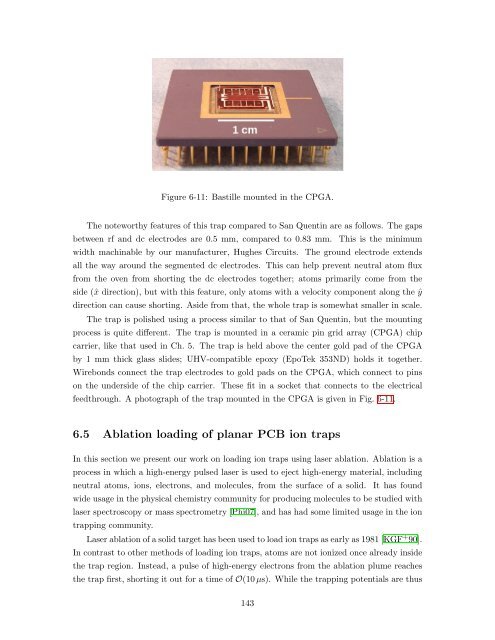Ph.D. Thesis - Physics
Ph.D. Thesis - Physics
Ph.D. Thesis - Physics
Create successful ePaper yourself
Turn your PDF publications into a flip-book with our unique Google optimized e-Paper software.
Figure 6-11: Bastille mounted in the CPGA.<br />
The noteworthy features of this trap compared to San Quentin are as follows. The gaps<br />
between rf and dc electrodes are 0.5 mm, compared to 0.83 mm. This is the minimum<br />
width machinable by our manufacturer, Hughes Circuits. The ground electrode extends<br />
all the way around the segmented dc electrodes. This can help prevent neutral atom flux<br />
from the oven from shorting the dc electrodes together; atoms primarily come from the<br />
side (ˆx direction), but with this feature, only atoms with a velocity component along the ˆy<br />
direction can cause shorting. Aside from that, the whole trap is somewhat smaller in scale.<br />
The trap is polished using a process similar to that of San Quentin, but the mounting<br />
process is quite different. The trap is mounted in a ceramic pin grid array (CPGA) chip<br />
carrier, like that used in Ch. 5. The trap is held above the center gold pad of the CPGA<br />
by 1 mm thick glass slides; UHV-compatible epoxy (EpoTek 353ND) holds it together.<br />
Wirebonds connect the trap electrodes to gold pads on the CPGA, which connect to pins<br />
on the underside of the chip carrier. These fit in a socket that connects to the electrical<br />
feedthrough. A photograph of the trap mounted in the CPGA is given in Fig. 6-11.<br />
6.5 Ablation loading of planar PCB ion traps<br />
In this section we present our work on loading ion traps using laser ablation. Ablation is a<br />
process in which a high-energy pulsed laser is used to eject high-energy material, including<br />
neutral atoms, ions, electrons, and molecules, from the surface of a solid. It has found<br />
wide usage in the physical chemistry community for producing molecules to be studied with<br />
laser spectroscopy or mass spectrometry [<strong>Ph</strong>i07], and has had some limited usage in the ion<br />
trapping community.<br />
Laser ablation of a solid target has been used to load ion traps as early as 1981 [KGF + 90].<br />
In contrast to other methods of loading ion traps, atoms are not ionized once already inside<br />
the trap region. Instead, a pulse of high-energy electrons from the ablation plume reaches<br />
the trap first, shorting it out for a time of O(10µs). While the trapping potentials are thus<br />
143
















